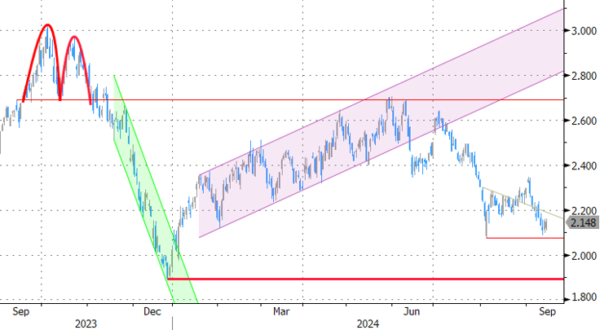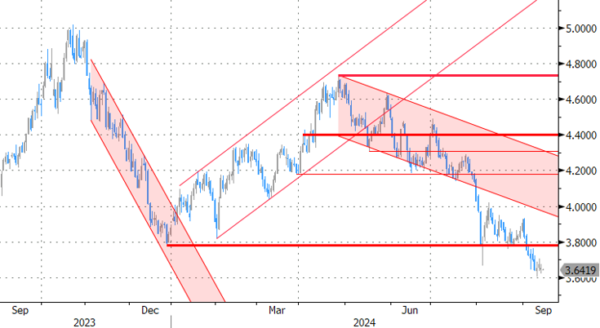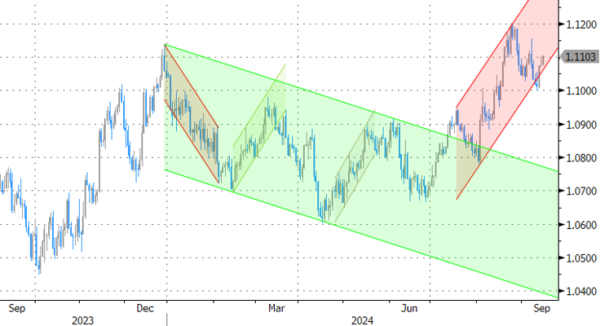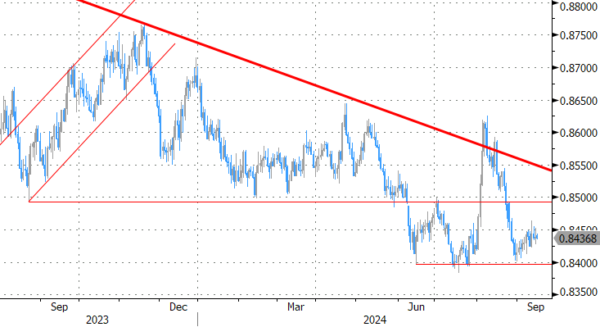Markets
(US) eco data on Friday were few and mostly second tier. US August import and export price data were softer than expected. The Michigan consumer confidence was slightly better than expected (69 from 67.9). The inflation expectations subindices (1-y 2.7% from 2.8%, LT 3.1% from 3.0%) also didn’t add much to the Fed easing debate. US yields declined further between 5.7 bps (2-y) and 0.9 bps (30-y) but most of this move already realized before the publication of the data. Market positioning was driven by considerations on what could/should be an appropriate Fed tactics. What Fed-strategy (fast 50 bps steps start, or gradual 25 bp lift-off) would best serve the Fed’s aim to engineer a soft landing with no additional further damage to the labour market? This debate, also ‘orchestrated’ by some high profile articles in the financial press (WSJ, FT) on Friday again tilted back to a growing chance of 50 bps first step (+/- 60% chance). German Bunds again underperformed Treasuries with yields changing between 1.4 bps (2-y) and +0.6 bps (30-y). ECB policy makers on Friday and this weekend basically confirmed ECB Chair Lagarde’s guidance from press conference on Thursday that easing of inflationary pressures should allow the ECB to cut rates further (Nagel, Wunsch) but they didn’t commit on the timing of further steps. EBC Holzmann indicated that December rather than October might be the right time for a next ECB cut. The revival of expectations on an aggressive start of the Fed easing cycle, this time again supported equities with the Dow (+ 0.72%) and the S&P 500 (+0.54%) again trading within reach of the all-time records. Easing of global financial conditions again put the dollar in the defensive. DXY again tested the 101 level but closed above (101.1). Gains in EUR/USD were marginal (1.1075). The yen still outperformed (USD/JPY close 140.85).
This morning, Japanese, mainland China and Korean markets are closed. Chinese August activity data (retail sales, production & investment data published this weekend) again showed a mediocre growth performance spurring calls for additional policy stimulus (cf infra). The dollar remains under pressure with EUR/USD testing the 1.11 barrier. USD/JPY (140.1) is even breaking below the key 140.25 area (December low). Today, the data calendar is thin with the US Empire manufacturing survey the exception to the rule (expected at -4.3 from -4.7). ECB governors Panetta, de Guindos and Lane are scheduled to speak. We don’t see much reason for markets to backtrack on its assessment of a growing chance for a 50 bps Fed inaugural rate cut on Wednesday. We don’t expect the US August retail sales (to be published tomorrow) to be a gamechanger anymore. On FX, USD weakness looks to be the by default FX bias going into the Fed policy decision. The Bank of England (Thursday) and the Bank of Japan (Friday) also will hold regular policy meeting but are expected to leave policy unchanged.
News & Views
UK property website Rightmove said that average asking prices for homes rose by 0.8% M/M in September following a steep 1.5% drop in August. It’s double the long-term average pace in September. The average price stood at £370 759, which is 1.2% higher on a yearly basis. Rightmove’s director of property science referred to the new government and the Bank of England’s first rate cut as key drivers. Improving buyer demand was also visible in the increase of number of sales agreed between buyers and sellers (+27% Y/Y). The average five-year fixed mortgage was 4.67% in September, coming off a 6.11% peak in July 2023. London house prices increased by 0.7% M/M (1.4% Y/Y) to average £682 375.
The People Bank of China on Friday signaled more action in fighting deflation and reviving the economy. In a rare statement, they vowed to make maintaining price stability and pushing for the mild rebound in prices an important consideration for monetary policy. They also stressed meeting reasonable financing demand for consumption in a more targeted way. Policymakers are “preparing to launch some additional measures, further lower the financing costs for businesses and households, and keep liquidity reasonably ample.” The central bank sets 5-yr (currently 3.85%) and 1-yr prime loan rates (3.35%) at its September 20 meeting. Both were reduced by 10 bps in July.
Graphs
GE 10y yield
The ECB cut policy rates by 25 bps in June and in September. Stubborn inflation (core, services) make follow-up moves less evident. We expect the central bank to stick with the quarterly reduction pace. Disappointing US and unconvincing EMU activity data dragged the long end of the curve down. The move accelerated during the early August market meltdown.
US 10y yield
The Fed in its July meeting paved the way for a first cut in September. It turned attentive to risks to the both sides of its dual mandate as the economy is moving to a better in to balance. The pivot weakened the technical picture in US yields. A string of weak eco data and a risk-off market climate pushed and kept the 10-yr sub 4%. We think we could be up to three 50 bps rate cuts this year.
EUR/USD
EUR/USD moved above the 1.09 resistance area as the dollar lost interest rate support at stealth pace. US recession risks and bets on fast and large rate cuts trumped traditional safe haven flows into USD. EUR/USD 1.1276 (2023 top) serves as next technical references.
EUR/GBP
The BoE delivered a hawkish cut in August. Policy restrictiveness will be further unwound gradually on a pace determined by a broad range of data. The strategy similar to the ECB’s balances out EUR/GBP in a monetary perspective. Recent better UK activity data and a cautious assessment of BoE’s Bailey at Jackson Hole are pushing EUR/GBP lower in the 0.84/0.086 range.

















